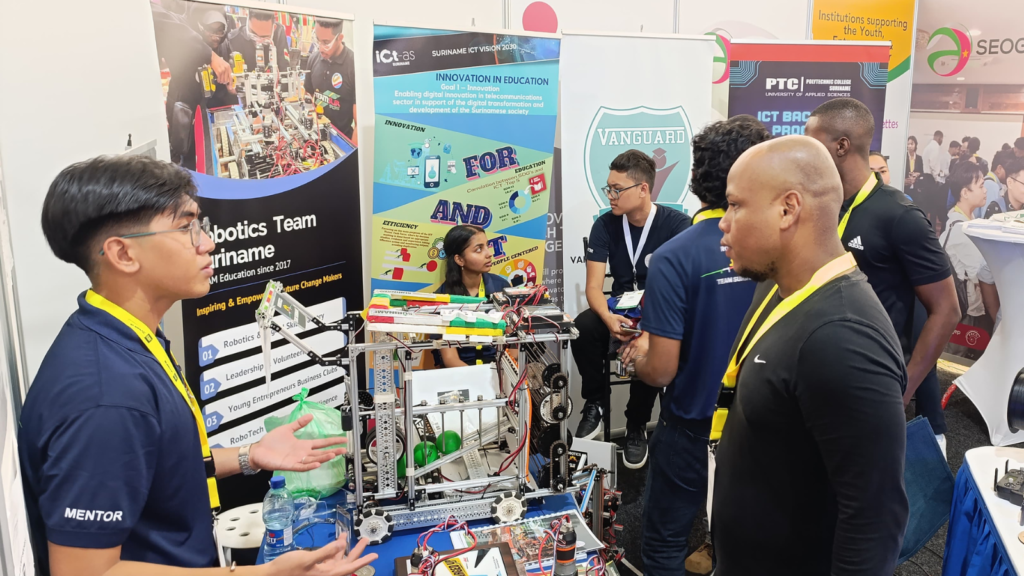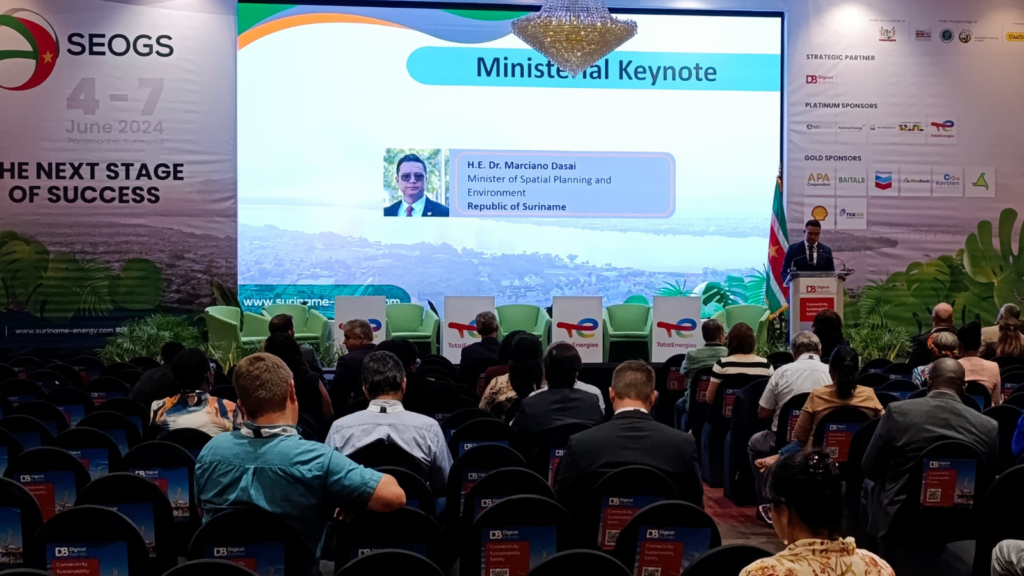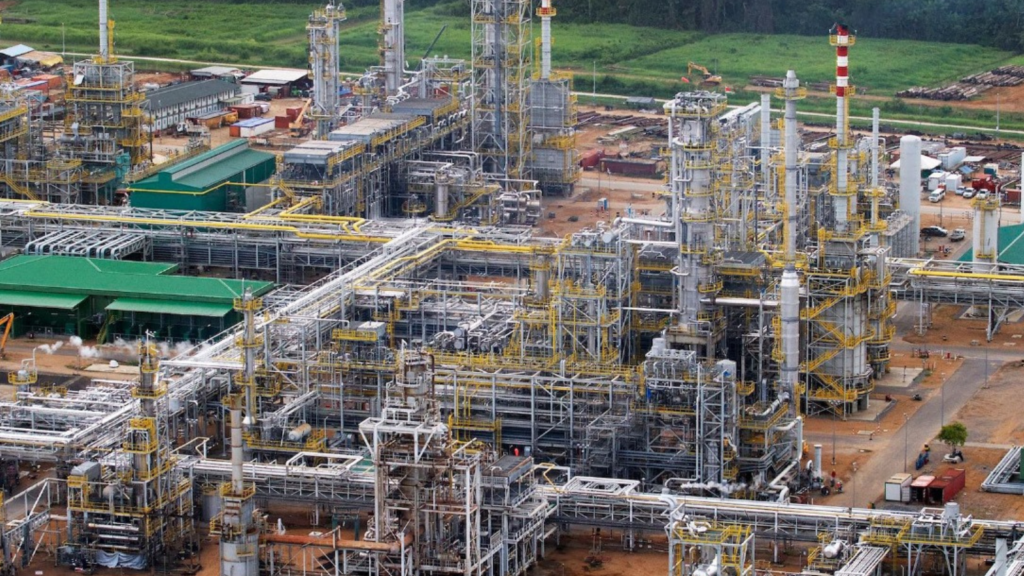During the fourth Suriname Energy Oil & Gas Summit (SEOGS), Suriname emphasised its determination to advance what it considers to be sustainable oil extraction, despite global concerns about climate change.
Their focus is on balancing economic growth with environmental responsibility, crucial for maintaining Suriname’s unique status as a net-negative CO2 country. Suriname’s deforestation rate ranges from only 0.05% to 0.07%, making it carbon-negative. This means Suriname’s forests absorb more carbon dioxide (CO2) than the country emits. According to the most recent data from the UN REDD+ program, Suriname recorded an emission reduction of 4.8 million tons of CO2 in 2021.
SEOGS, featuring over 150 speakers, 8,000 attendees, and 200 exhibitors, was held from June 4 to 7, 2024, in Paramaribo, Suriname, under the theme ‘the next stage to success’. During this summit, various countries gathered to discuss further development of the oil and gas sector, primarily in the Caribbean region. Summit speakers highlighted how regional countries can prosper from oil and gas discoveries while remaining mindful of climate challenges.

The SEOGS summit also served as a platform to discuss climate justice, emphasising the importance of ensuring that the benefits of oil and gas development are equitably distributed among all segments of the population, particularly marginalised communities. Speakers at the event also pointed out that as developing countries like Suriname and Guyana harness their natural resources for economic growth, it is crucial to address historical inequities and ensure that local communities directly benefit from these developments.
In an exclusive interview, Annand Jagesar, Managing Director of Staatsolie Maatschappij N.V., stated that despite developments in the oil and gas industry, Suriname will remain carbon-negative. He explained that Suriname currently absorbs more CO2 than it emits, a trend expected to continue even with future growth in the oil and gas sector.
“The calculations are there. Suriname is now a carbon sink; we absorb more CO2 than we emit. With the future development of the oil and gas sector, this will remain the case, as our negative emissions offset any increased emissions from that sector,” said Jagesar.

Sustainability in reference to oil and gas?
Suriname’s focus on bringing prosperity to its people through the oil and gas sector is also evident in neighbouring Guyana. Peter Ramsaroop, Chief Investment Officer of the Guyana Office for Foreign and Local Investment, announced that Guyana will produce 1.3 million barrels of oil per day by 2027. He assured SEOGS attendees that Guyana, like Suriname, will continue to provide global oxygen by minimising deforestation.
“Our country has achieved sustainable development by preserving our forests. We have ensured food security for the region and will continue to do so. Unlike other countries, we have expertise in agriculture, mining, forestry, and the service sector. In Guyana, we are modernising these industries to sustain long-term prosperity. If the world tells us not to extract oil, we will tell them to be silent. It’s time for our people in this region to enjoy the benefits of oil and gas prosperity, but we will do so with sound governance.”
Collaboration with Guyana
Jagesar noted existing protocols in both Suriname and Guyana to address potential environmental issues resulting from oil extraction. Contingency plans are in place in case of an oil spill. He emphasised that Suriname and Guyana work with contractors such as Exxon in Guyana and Total in Suriname, which are responsible for responding to emergencies.
“These companies must have adequate insurance and agreements with international firms capable of cleaning up oil spills.”
Staatsolie is investing in special installations to minimise emissions, both onshore and offshore. For instance, gas released during oil production in Saramacca is used to generate heat, preventing its release into the atmosphere, Jagesar explained. The Staatsolie CEO also mentioned that Suriname and Guyana are investing in emission reduction.
“We are constructing facilities to minimise CO2 emissions, which requires additional investments. A large pump alone costs nearly USD 100 million to keep gas in the reservoir rather than letting it escape into the atmosphere.”

Investing in a dying industry?
During SEOGS, Kimberly Harrington, Deputy Assistant Secretary of Energy Resources at the US Department of State, highlighted the global shift from fossil fuels to sustainable energy sources. She acknowledged that this transition will not happen overnight.
In the meantime, she advocates for sustainable oil extraction in countries like Suriname and Guyana, where the oil and gas industry is expanding. Harrington emphasised the sector’s role in ensuring energy security while contributing to climate change mitigation.
She commended Suriname for participating in the global methane pledge, promoting international cooperation to reduce methane emissions. This initiative is crucial as it not only reduces environmental impact but also offers economic benefits through efficient energy use.
In addition to reducing greenhouse gas emissions, Harrington stressed the importance of investing in renewable energy sources such as hydroelectric power. These sources, like Suriname’s carbon-negative forests, play a key role in transitioning to a sustainable energy mix. She underscored that robust green energy policies are essential for long-term stability and prosperity.
Protecting biodiversity
Staatsolie is implementing measures to protect biodiversity in its operational areas. “In Saramacca, we have preserved the swamp and use airboats. By restricting hunters from the swamp area, it is now thriving with jaguars,” Jagesar said. This demonstrates that human activity and conservation can coexist.
One of the biggest challenges in implementing environmental regulations is cost. Jagesar explained, “It all costs money. NIMOS has regulations stating that there may be 10 parts per million (PPM) of oil in every part of water.” He emphasised that Staatsolie will comply with these rules, even though they entail expenses. NIMOS stands for the National Institute for Environment and Development in Suriname, established to structure environmental management by formulating part of the environmental legislation and ensuring compliance with that legislation.
International support needed
The Staatsolie CEO stressed the importance of international support in addressing climate change. “Rich countries promised USD 100 billion at COP 28 to support developing countries in implementing measures such as protecting low-lying coastal areas and forests. However, little has materialised. We must find ways to assist our population while working towards sustainable solutions.”
Minister Marciano Dasai of Spatial Planning and Environment discussed the plan to sell Internationally Transferred Mitigation Outcomes (ITMOs) based on Suriname’s net removal capacity.
“This illustrates our commitment to linking economic development with environmental responsibility. By using ITMOs to offset emissions from the oil and gas industry, Suriname remains committed to achieving national climate goals and complying with international treaties like the Paris Agreement.”
ITMOs are a mechanism under the Paris Agreement framework that allows countries to internationally trade greenhouse gas emission reductions. These reductions can be used to achieve a country’s Nationally Determined Contributions (NDCs) for emission reduction.
The discussions and plans highlighted at SEOGS underscore the critical need for climate justice. By ensuring that the economic benefits from oil and gas extraction are shared with all segments of society, particularly the most vulnerable, Suriname and Guyana are paving the way for more inclusive and equitable development. This approach not only addresses environmental sustainability but also promotes social and economic fairness, reinforcing the idea that climate action and justice must go hand in hand.
However, the government of Suriname has not presented any specific plan or document in which it is explains where all the income from oil and gas shall go. Meanwhile, the country is eagerly awaiting the FID for Block 58 by the end of this year.
—
This story was originally published by Key News Suriname, with the support of the Caribbean Climate Justice Journalism Fellowship, which is a joint partnership between Climate Tracker and the Open Society Foundations.